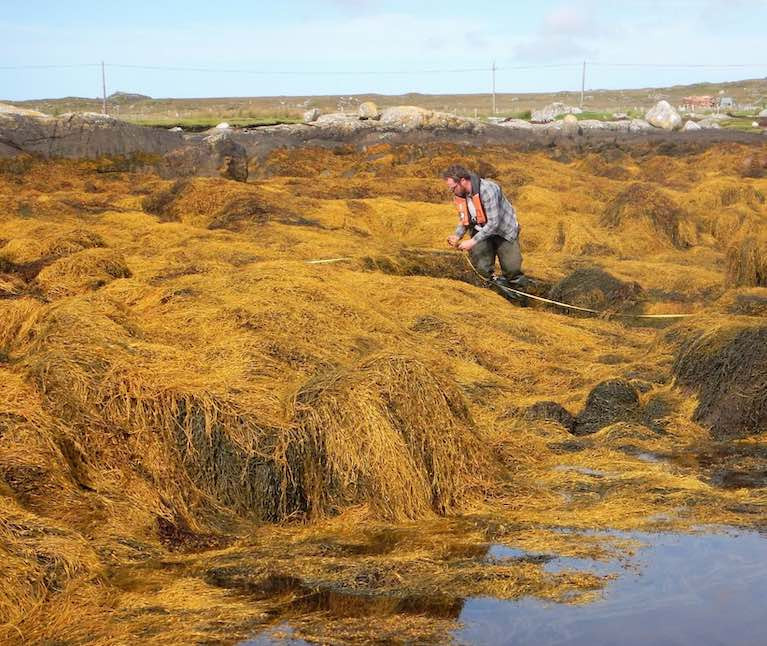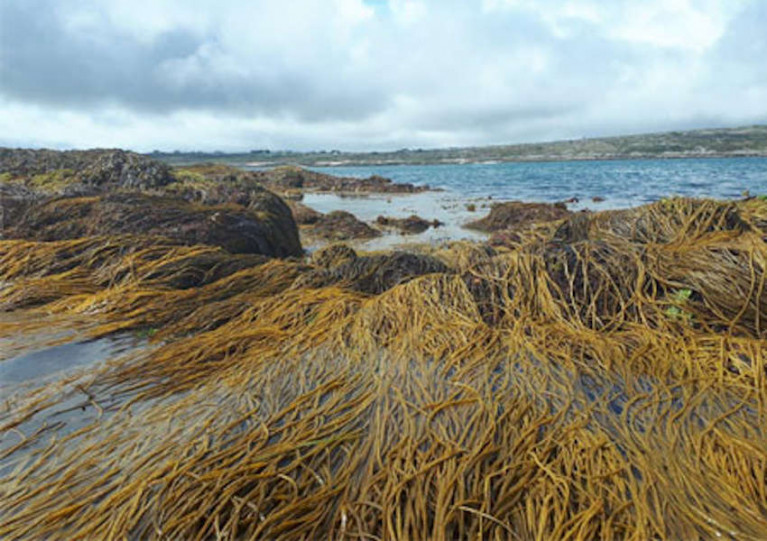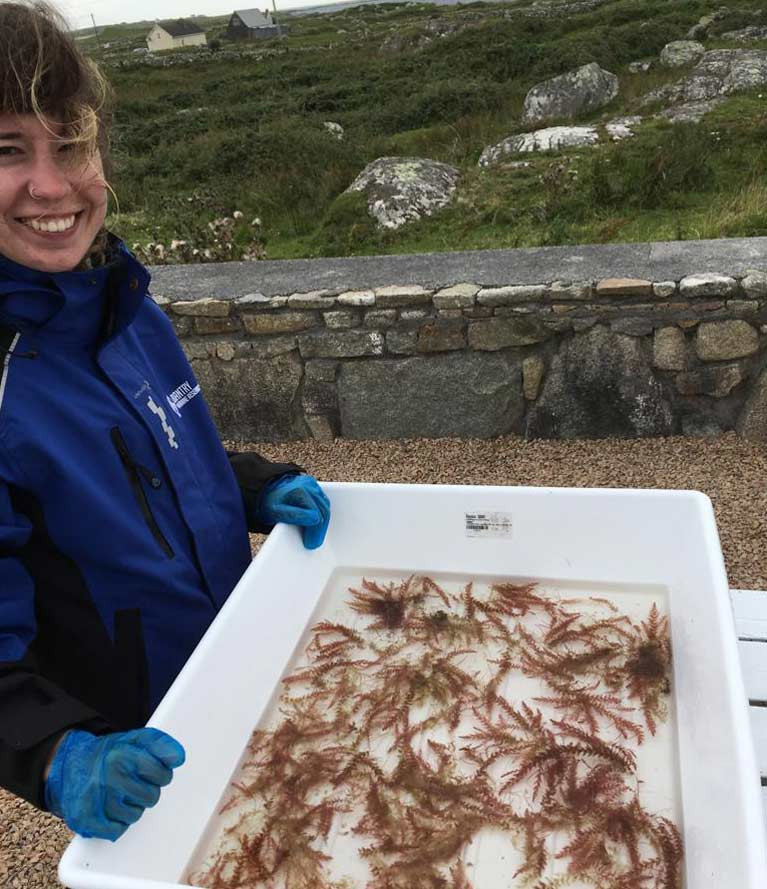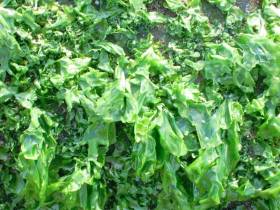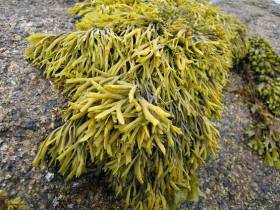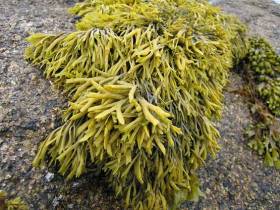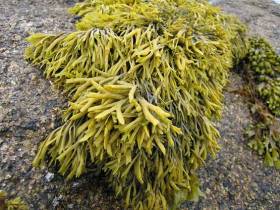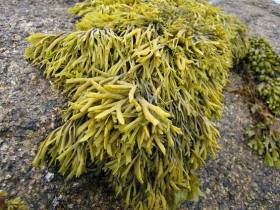Displaying items by tag: Seaweed
New Investment in Connemara Seaweed Plant as Covid 19 Benefits Harvesting
Hand-harvesting seaweed on the Irish Atlantic coast experienced an unexpected boost due to Covid-19, according to Canadian-owned seaweed company Arramara Teo.
Construction workers with coastal connections opted to supplement incomes on the shoreline, and there are now large quantities in storage, Arramara’s Europe director Jim Keogh has said.
The Connemara-based company plans to make a “significant” investment in upgrading its existing seaweed processing plant in Cill Chiaráín, Co Galway, Mr Keogh confirmed on Monday.
This will allow it to handle other types of seaweed for the health food and other markets, he said.
The investment to a “food grade” plant, believed to be under 0.5 million euro, will be funded through Arramara’s own resources.
Among the main species targeted will be Fucus vesiculosus or bladderwrack, a brown seaweed rich in iodine.
It grows alongside Ascophyllum nodosum or “feamainn bhuí” which harvesters currently supply for use in fertiliser and animal feed.
“Fucus vesiculosus grows back quicker than the Ascophyllum, which will give harvesters more options,” Mr Keogh said.
The company would also look at the potential of other inter-tidal species, such as dulse and carrageen, he said.
The company will be able to avail of international markets through Acadian’s extensive global network, Mr Keogh said.
Currently, harvesters are paid €55 a tonne for Ascophyllum nodosum.
Some 50 per cent of the Cill Chiaráin plant’s stock is sold on the domestic market, and 50 per cent goes for export, Mr Keogh said.
He confirmed there were large quantities still in storage due to this year’s bumper harvest, but this was a “normal” part of the cycle, he said.
The company, which employs 24 people directly, is currently on a three-day working week.
Arramara Teo, formerly State-owned, was founded in 1947 and was purchased by Canadian multinational Acadian Seaplants six years ago.
The planned upgrade at the Cill Chiaráin plant will take about four weeks and will begin February, Mr Keogh said.
“ This investment is one of the founding pieces in the planned operational expansion of Arramara Teo, which will have far-reaching economic benefits within the local community and west coast of Ireland,” he said.
Research Contracts Awarded to Develop Ireland’s Seaweed Resource
Three Irish consortiums have been awarded Small Business Innovation Research (SBIR) contracts by the Marine Institute and Enterprise Ireland to develop Ireland’s intertidal seaweed resource.
The Phase 1 ‘Challenge’ contracts will run over four months, and will involve scientific observations by satellite, drone and light aircraft to produce accurate estimates of seaweed distribution and biomass, and improve our understanding of Ireland’s coastal marine habitat and ecosystems.
Successful projects may then proceed to scaled-up demonstrations and wider regional resource mapping during 2021.
The move is in response to increasing demand at home and abroad for seaweed and seaweed-based products — from fertilisers and animal feed to cosmetics, medicines and food.
It is estimated that 32 countries actively harvest over 800,000 tonnes from wild stocks and natural beds annually. And in Ireland, the Marine Institute says commercial interest in the sector is growing.
Mick Gillooly, director of oceans, climate and information services at the Marine Institute, says: “With increasing awareness of the economic value of seaweed, mapping the extent of this resource is vital for sustainable management decisions.
“This is an exciting collaboration between industry, small business and research institutions, which will utilise the latest innovations and the expertise of Ireland’s national seabed mapping programme INFOMAR.”

Among the three consortiums in receipt of these contracts are four SMEs, two research groups and two industry partners.
Supported by IT Carlow, Aerial Agri Tech bring their drone mapping expertise from the terrestrial to the marine domain with industry partner Bláth na Mara (Aran Islands Seaweed).
Fathom, a business technology consulting company based in Dublin, has partnered with Earth and Ocean Sciences at NUI Galway and Arramara Teo to focus on the potential for satellite data augmented by ‘groundtruthing’ (direct observations on the ground).
Meanwhile, Techworks Marine, a provider of oceanographic solutions to monitor the marine environment, has teamed up with GeoAerospace — a geospatial information technology company with expertise in space-borne and airborne remote sensing, cloud platforms and machine learning — and with NUI Galway’s School of Botany and Plant Science.
Phase one will see the three groups develop their projects and feasibility plans. Pending evaluation in early 2021, either one or two consortiums will receive further funding to move into Phase 2A — eight months to demonstrate proof of scalability and lay out a path to commercialisation.
Successful partnerships will have the potential to develop a niche coastal habitat mapping service that could be used to tackle marine pollution, harmful algal blooms or invasive species.
The spotlight is on seaweed and other renewable biological resources this week for Bioeconomy Ireland Week 2020 — which begins today, Monday 19 October.
A series of online events from leading stakeholders within the Irish Bioeconomy Network will showcase resources sourced sustainably from land and sea which, along with their byproducts, are later converted into “value-added bio-based products” such as proteins, feeds, fertilisers, plastics and energy.
Marine-related highlights of the week include the launch of Bord Iascaigh Mhara’s (BIM) report on ‘Scoping a Seaweed Bio-refinery Concept for Ireland’ this Thursday 22 October, and Friday’s online workshop on ‘Sustainable Seaweed’ organised by Údarás na Gaeltachta.
Industry representatives say the bioeconomy has the potential to create new sustainable opportunities for farmers, and lead to the creation of high-quality green jobs in rural and coastal areas.
Noting the “unprecedented and difficult position” resulting from the coronavirus pandemic, Minister of State Martin Heydon says: “We have the opportunity to reformulate our economy and the bioeconomy provides opportunities to rebuild and restructure in a green sustainable and circular way for our primary producers, as well as the agri-food, marine, forestry, waste management, energy, construction, pharmaceutical and biotechnology sectors. We must build back better.”
Minister Heydon also joined Environment Minister Eamom Ryan in announcing the launch of the National Bioeconomy Forum.
This forum intends to provide a voice for the bioeconomy industry, relevant state bodies and community groups, as well as “promote, support and advocate for the sustainable development of the bioeconomy in Ireland”.
For full list of events taking place this week, registration for access and for more information of Bioeconomy Ireland, visit the website at www.irishbioeconomy.ie
Scientists in West Cork are reporting significant results in use of a type of red seaweed to reduce methane emissions in cattle.
Cuts of between 40 and 98 per cent in emissions have already been achieved in trials in the US, Australia and New Zealand, Bantry Marine Research Station has told The Farmers’ Journal and The Irish Independent.
The West Cork research station, which is now owned by veterinary pharmaceuticals company Bimeda, has been testing effectiveness of red seaweed species Asparagopsis armata in animal feed here.
Canadian scientist Dr Rob Kinley, who pioneered research on its use with the Australian Common Scientific and Industrial Research Organisation (CSIRO), has been collaborating with the Bantry station, managed by David O’Neill.
Asparagopsis armata which was discovered in Irish waters about 60 years ago and cultivated in the late 1990s in Ard Bay, Co Galway by research company Taighde Mara Teo, would have to be farmed here to meet sufficient quantities, O’Neill points out.

He estimates animals fed with the constituent here could reduce emissions by 50 to 60 per cent.
The marine research company is co-operating with Udaras na Gaeltachta and Teagasc, and hopes to raise funds for more animal trials.
Údaras na Gaeltachta director of enterprise, employment and property Dr Mark White said there could be a double benefit for both farmers and climate change targets if the Bantry station’s work on the red seaweed additive does prove fruitful.
Teagasc principal research officer Prof Sinead Waters, who is also adjunct professor at the Ryan Institute, NUI Galway, said that while initial results from Australia and elsewhere are positive, “further research is warranted”.
 Dee McElligott examines the red seaweed Asparagopsis armata in tests at Bantry marine research station, Co Cork
Dee McElligott examines the red seaweed Asparagopsis armata in tests at Bantry marine research station, Co Cork
Prof Waters and Teagasc colleague Dr Maria Hayes, are involved in two projects testing various feed additives to reduce methane - “Meth-Abate” funded by the Department of Agriculture, Food and Marine, and “SeaSolutions” an EU- funded project with other Irish, EU and Canadian partners.
“There are a lot of caveats, such as bromoform, a compound within seaweed which is a known to reduce methane emissions but is also a known carcinogen. We need to ensure that if seaweed is fed to ruminants that no bromoform or other residues appear in the end meat and milk products,” Prof Waters said.
For more, read The Farmers’ Journal and The Irish Independent reports here
Nitrates and phosphates from intensified agriculture are a significant cause of so-called green and red tides in West Cork, according to a new report.
Dr Liam Morrison, one of the researchers behind the NUI Galway study, tells the Southern Star that more must be done to keep farm nutrients from flowing out to coastal areas where they feed the growth of red and green seaweed or sea lettuce blooms.
While these blooms currently pose no heath risk to humans, the report alleges that they cause issues for inshore navigation, sea angling and ultimately tourism.
However, the Irish Farmers’ Association says agriculture cannot be solely to blame — citing a reduction in seaweed blooms in areas where wastewater treatment schemes have been upgraded.
The Southern Star has more on the story HERE.
#Seaweed - The State cannot licence seaweed harvesting in a era where harvesting rights already exist.
That is the official position of the Department of Housing, Planning and Local Government, following “ongoing assessment of the legal interaction” between applications for licenses and existing seaweed harvesting rights around the Irish coast.
Speaking at the recent Our Ocean Wealth Summit in Galway, Minister of State Damien English said: “I have taken the necessary time to carefully consider all aspects of this issue and have met with a variety of interests across this sector. The position is that my department cannot licence seaweed harvesting in an area where there is an existing right to harvest seaweed.
“I have also clarified that existing seaweed rights holders can continue to exercise their right to harvest seaweed and do not require consent under the Foreshore Act although they must respect relevant national and European environmental legislation.”
Minister English said he has written to all of the existing applicants setting out the position, and would work with them to consider how it would impact on their applications.
“In the course of the consideration of these issues, I have had the welcome opportunity to meet many people in this sector and listen to their views. One of the things I took from these interactions is the great potential to develop the wild seaweed sector if we take the right decisions to realise it.
“I will be working with my colleagues to identify the most suitable body to develop and implement a strategy to underpin the development of this sector which will need to include a robust and transparent licensing system.”
BioAtlantis Aquamarine recently began mechanical harvesting of sub-tidal seaweed in Bantry Bay despite a High Court challenge to the project by environmental groups, as previously reported on Afloat.ie.
Seaweed Harvesting Begins In Bantry Bay
Mechanical harvesting of sub-tidal seaweed was set to begin today (Wednesday 4 July) in Bantry Bay.
Operations by BioAtlantis Aquamarine Ltd, using the Atlantis Explorer (Callsugn EIPQ2) are expected to continue for the duration of the licence until 2024. Harvesting will take place in Areas A, B, C, D and E of the licence area, details of which are included in Marine Notice No 29 of 2018, available to read or download HERE.
The harvesting operations are proceeding despite a High Court challenge to the project by a number of environmental groups, according to The Irish Times.
The High Court has granted a judicial review of the licence awarded in November last year, and opposed by the Bantry Bay - Save Our Kelp Forests group, among others, for its alleged potential to “irreversible damage to the ecosystem and businesses of the Bantry Bay area”.
The Irish Times has more on the story HERE.
Bantry Bay Residents Speak Out Over Seaweed Harvesting Licence
#CoastalNotes - While Bantry Bay prepares to open up as a maritime hub for Ireland’s South West, local coastal residents are expressing concern over the first State licence for the mechanical harvesting of seaweed.
As the Irish Examiner reports, Kerry-based BioAtlantis secured the licence after a five-year application process — but now faces growing opposition from local communities, many of which have hand-harvested seaweed for hundreds of years, who claim lack of consultation over the plans.
Pantry resident Deirdre Fitzgerald said the issue only came to wider public attention earlier this year, when an episode of RTÉ One’s Eco Eye detailed the planned harvest of nearly 2,000 acres of kelp forest.
“We have white tailed eagles resident in the bay, whales, dolphins, seals, otters, and so many bird species that rely on this bay for food,” she told the Irish Examiner. “What will be the impact on juvenile fish as a food source for all these species once this kelp is removed from the bay?”
However, BioAtlantis chief executive John T O’Sullivan said “everything was done by the book” in relation to its application process. The Irish Examiner has much more on this story HERE.
In other coastal news, objectors to Galway Bay’s marine energy test site have questioned the legality of the foreshore lease application, pointing out that a number of key documents were not included, according to the Connacht Tribune.
The same newspaper also reports on claims of “outrageous” public expenditure on the now-shelved Galway Bay fish farm project, a controversial scheme that cost the State more than half a million euro.
#Seaweed - Could breathing in the iodine released by seaweed on Ireland's coasts be improving our health?
The answer is quite possibly, according to new research as reported in The Irish Times this week.
Scientists at UCD and NUI Galway have concluded that iodine levels are highest among those regularly breathing coastal air rich in seaweed, which concentrates iodine from seawater.
Their paper in the Irish Medical Journal was informed by two decades of studies in three different environments in Ireland: coastal cities (Dublin, Belfast, Galway), inland areas (Mullingar and Dungannon) and seaweed-rich Carna in Co Galway, where almost half the population has iodine intake above the WHO recommended level.
The Irish Times has much more on the story HERE.
Coastal Communities Integral To Any 'Blue Growth' Strategy Says UN Expert
#CoastalNotes - The rights of coastal communities involved in the likes of small-scale fishing and seaweed harvesting must be respected in any 'Blue Growth' strategy, a UN expert has said.
The Irish Times reports on comments made by UN fisheries chief Dr Rebecca Metzner upon her visit to Galway this week, where she heard the concerns of inshore fishermen who have protested against large-scale fish farming.
Local campaigners breathed relief in December when Bord Iascaigh Mhara (BIM) withdrew its application for what would have been the largest organic salmon farm in Europe, based off the Aran Islands in Galway Bay.
While recognising that aquaculture is required to "fill the gap" in the growing global demand for seafood, Dr Metzner emphasised that dialogue over shared access between local communities and larger commercial interests should be fundamental to any such plans.
She also heard from Connemara seaweed harvesters, who fear the loss of access to the coastline over legislation that may allow harvesting rights to be snapped up by much bigger State-owned enterprises – a situation the Government promised to review two years ago.
The Irish Times has more on the story HERE.


























